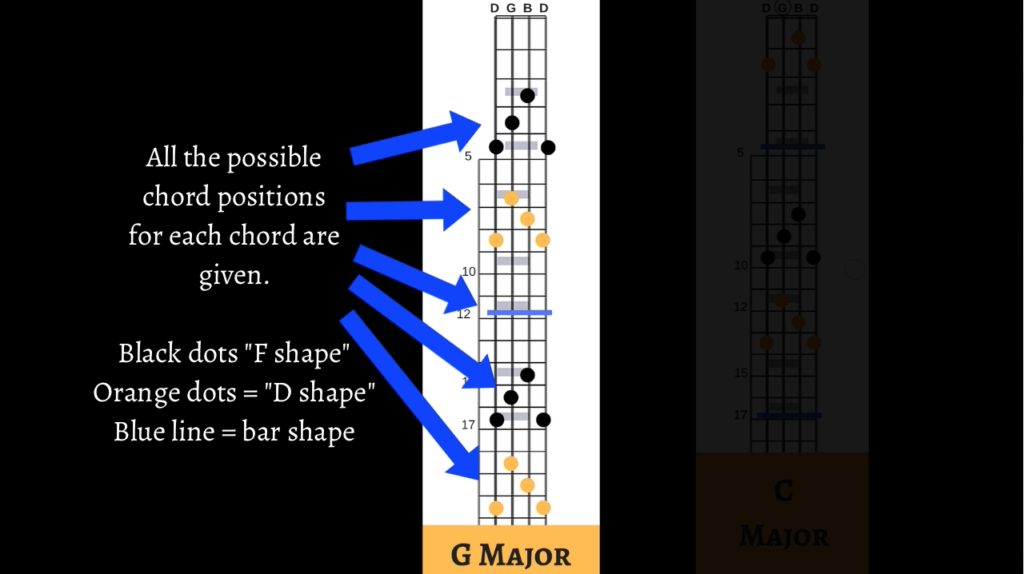How To Use The Backup Tracks Video
Backup tracks are an incredibly useful tool for the aspiring banjoist.
From learning new tunes, developing your ear and the ability to hear chord progressions, practicing new chord positions and chord changes, practicing backup licks, improvising, and so on.
I’ve been using them for years for fun and practice, and have combined all the things I’d always wanted in a backup tracks into the ones you’ll find here.
They’re to function as a Swiss Army Knife, to maximize their benefits by allowing you to work on multiple aspects of banjo playing and jamming. And they’re designed to grow with you as a player – as your skills evolve over time, so will the way in which you use these tracks.
[RELATED: Coming soon – the “Essential Bluegrass Banjo Songs” book of tabs, tune tutorials, and backup tracks as seen here. Click here to have them sent you as soon as they’re ready (free)]Backup Track Orientation
First, here’s a brief overview of how the tracks are set up.
Each backup track video will open with the title of the song and the tempo (you’ll typically find a moderate tempo and a slow tempo track).

The track will then alternate between the banjo taking a solo break and then dropping out. The guitar will continue its backup throughout.
Learning the Fretboard
While the banjo is playing lead, you’ll see the chord of the moment is displayed on screen. You’ll also note that a diagram is provided that shows all the possible locations and fingerings of the chord on the fretboard.

You’ll also see another chord and accompanying diagram displayed more faintly in the background. This is the chord that’s coming up next.

The track will continue to alternate in each run through the song with the banjo taking a lead break and then dropping out. This will allow you to practice playing backup while the banjo is playing lead, and then taking the lead yourself when the banjo drops out. That said, you’re also free to use these tracks in any manner you see fit!
Ways To Use the Tracks
USE #1: Learning and practicing a new tune. The tracks are great for working on a new tune after you’ve first learned it (each of the songs has a separate tune tutorial video as well).
All of the backup tracks have a separate tune tutorial video that plays the tune in tandem with the tablature with close ups of the hands. Here’s an example video:
Here’s a suggested procedure for using the tune tutorial videos and backup tracks together:
- Learn the song using the tune tutorial video.
- Once you can play the song from memory, practice it along with the slow tempo backup.
- Once you can play the song cleanly along with the slow tempo, practice playing along with the moderate tempo tracks.
USE #2: Learning and practicing backup. These tracks can also be used to focus exclusively on your backup – practicing the various chord positions up and down the neck, making changes from one chord to another, backup licks, and so on. Since the chords are displayed during each banjo solo, you can use the time when they aren’t displayed to test your recollection and ability to hear the chord progressions.
This is also a great way to both learn and internalize the banjo fretboard, since all the positions for each chord on the fretboard are displayed each time the chords is called for. With repeated exposure, knowing these various locations – which is a huge asset when playing backup – will become second nature.
Furthermore, knowing the various positions of each chord up and down the neck is also the ideal shortcut when trying to work out up the neck breaks, and is essential piece of being able to improvise.
USE #3: Practicing jamming skills. What’s the best way to learn how to jam? By practicing jamming!
There’s no better way to practice jamming and build your confidence than by practicing in a way that replicates a jam experience, which is what these tracks are designed to do.
The tracks are already set up to give you the opportunity to alternate between playing a solo “break” on your banjo, and playing backup. When you hear the banjo being played, that’s your cue to play backup. When the banjo drops out, it’s your turn to take a solo.
Do this as a regular part of your practice routine and, unlike most first time jammers who walk in feeling intimidated and leave disappointed, you’ll find yourself brimming with confidence, and walk away wondering when you get to do it all over again!
The Ultimate Banjo Song Library
If you enjoy these backup tracks and would be interested in having access to a large and expanding library of them (plus tune tutorials), then you may be interested in the Breakthrough Banjo course for fingerstyle banjo. The course officially launches on March 21. Sign up today as a Founding Member and get an entire month for free. Click here for more information on the course, or register by clicking the button below.
